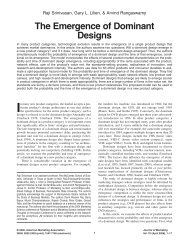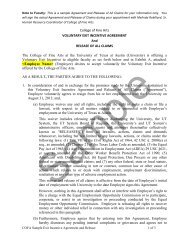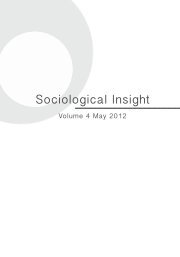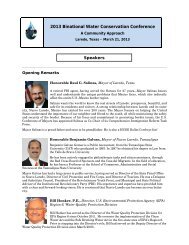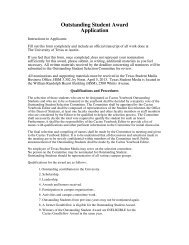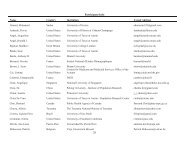Francois Herrmann – Spatial regression models - University Blog ...
Francois Herrmann – Spatial regression models - University Blog ...
Francois Herrmann – Spatial regression models - University Blog ...
You also want an ePaper? Increase the reach of your titles
YUMPU automatically turns print PDFs into web optimized ePapers that Google loves.
• Describe spatial <strong>regression</strong> techniques• Illustrate their use in the study of the associationof geographic, climatic and longevity data fromJapan.
Deaths from cholera in 1854compared with calculated mortalitySnow, "Cholera and thewater supply in the southdistricts of London,"Table 6http://johnsnow.matrix.msu.edu/book_images10.php
John Snow’s Original map (1854)Snow, John. On the Modeof Communication ofCholera, 2nd Ed, JohnChurchill, New BurlingtonStreet, London, England,1855.
Kernel Density to calculate the spatial densities ofdeaths around each of the wellshttp://www.udel.edu/johnmack/frec682/cholera/cholera2.html
Animal movementsGlobal positioning system (GPS) and satellite trackingDelaunay triangulation model of movement trajectories (a) and corresponding densitysurface, home range, and core area delineation (b) for a Florida panther.J. A. Downs et al., Computers, Environment and Urban Systems 36, 302-310 (2012).
Housing price in MilwaukeeFloor SizeHigh : 119.49Low : 17.63Air ConditionerHigh : 55860.63Low : -7098.88Fire PlaceHigh : 74706.97Low : -6722.29ABC±Num. of BathrmHigh : 39931.12Low : -2044.24House AgeHigh : 929.44Low : -1402.30Soil & Imp. SfcHigh : 34357.96Low : -220301.55DEF0 5 10 20KilometersFrom Geographically weighted <strong>regression</strong>By Danlin Yu Yehua Dennis Wei Dept. of Geog., UWM
• Points• Lattice• Geostatistics<strong>Spatial</strong> data<strong>Spatial</strong> dataFrom Baddeley A et Turner R. Spatstat: An R Package for Analyzing<strong>Spatial</strong> Point Patterns; J. of Statistical Software 12(6) 2005http://www.mendeley.com/catalog/journal-statistical-software-24/#page-1
<strong>Spatial</strong> data• Points• Lattice• GeostatisticsM. Jalili et al., Weighted coupling for geographical networks: Application to reducingconsensus time in sensor networks Physics Letters A 374, 3920-3925 (2010).
Air trafic interactive visualization of streaming datawith kernel density estimation
<strong>Spatial</strong> data• Points• Lattice• AreaJ. Ballester, JM Robine, FR <strong>Herrmann</strong>, X Rodó. Long-term projections and acclimatizationscenarios of temperature-related mortality in Europe. Nat Commun 2:358 (2011)
<strong>Spatial</strong> data• Key components of spatial data:– <strong>Spatial</strong> information (coordinates)– AttributesJ. Ballester et al., Nat Commun 2:358 (2011)
<strong>Spatial</strong> AutocorrelationTest for the presence of spatial autocorrelation– Global• Moran’s I• Geary’s C– Local (LISA – Local Indicators of <strong>Spatial</strong>Autocorrelation)• Local Moran’s I and Getis G i *www.clas.ufl.edu/users/forrest/teaching_geo.htmlForest R. Stevens, <strong>University</strong> of Florida 2012
Moran's I-1 0 +1Perfect dispersion Random spatial pattern Perfect correlationhttp://en.wikipedia.org/wiki/Moran%27s_I
C measure of non-randomness• Pointsr lp distance from random location to its nearest pointsr pp distance from sample points to nearest point Pielou, E. C. (1969)N. Coops et al., Remote Sensing of Environment 71, 248-260 (2000).
<strong>Spatial</strong> Weights MatricesNeighborhoods can be defined in multiple ways– Contiguity (common boundary)• But what is a “shared” boundary?– Distance (distance band, K-nearest neighbors)• How many “neighbors” to include, what distance do we use?– General weights (social distance, exponential decay)www.clas.ufl.edu/users/forrest/teaching_geo.htmlForest R. Stevens, <strong>University</strong> of Florida 2012
<strong>Spatial</strong> Weights MatricesNeighborhoods can be defined in multiple ways– Contiguity (common boundary)• But what is a “shared” boundary?– Distance (distance band, K-nearest neighbors)• How many “neighbors” to include, what distance do we use?– General weights (social distance, exponential decay)
Neighbours and bandwidthW spatial weight matrix1 NeighborDistance Band 1 unit3 NeighborsDistance Band 2 units
Intuition: you are your neighboursneighbour1Steve Gibbons 2008, GY460 Techniques of <strong>Spatial</strong> AnalysisLecture 3: <strong>Spatial</strong> <strong>regression</strong> and ‘neighbourhood’ effects <strong>models</strong>http://www.docstoc.com/docs/109574884/GY460_Lecture_3_<strong>Spatial</strong>_Regressions_Oct_08
Intuition: you are your neighboursneighbour2 1Steve Gibbons 2008, GY460 Techniques of <strong>Spatial</strong> AnalysisLecture 3: <strong>Spatial</strong> <strong>regression</strong> and ‘neighbourhood’ effects <strong>models</strong>http://www.docstoc.com/docs/109574884/GY460_Lecture_3_<strong>Spatial</strong>_Regressions_Oct_08
…and your neighbour’s neighbour’sneighbour’s neighbour…321Steve Gibbons 2008, GY460 Techniques of <strong>Spatial</strong> AnalysisLecture 3: <strong>Spatial</strong> <strong>regression</strong> and ‘neighbourhood’ effects <strong>models</strong>http://www.docstoc.com/docs/109574884/GY460_Lecture_3_<strong>Spatial</strong>_Regressions_Oct_08
…and your neighbour’s neighbour’sneighbour’s neighbour…3 4Shocks at 1 affect 2 and4 directlyAnd 3 indirectly via 2and 4Shocks at 1 get reflectedback to 1 from 2 and 4And from 2 to 3 to 4 to1 etc…21Steve Gibbons 2008, GY460 Techniques of <strong>Spatial</strong> AnalysisLecture 3: <strong>Spatial</strong> <strong>regression</strong> and ‘neighbourhood’ effects <strong>models</strong>http://www.docstoc.com/docs/109574884/GY460_Lecture_3_<strong>Spatial</strong>_Regressions_Oct_08
Linear <strong>regression</strong> <strong>models</strong>X j70 0 1CR= β + β X + εCR 70, jε j
Linear Regression• When applied to spatial data, it assumes astationary spatial process– The same stimulus provokes the same responsein all parts of the study region– Highly untenable for spatial processFrom Geographically weighted <strong>regression</strong>By Danlin Yu Yehua Dennis Wei Dept. of Geog., UWM
<strong>Spatial</strong> error <strong>regression</strong> <strong>models</strong>X j X kW spatial weight matrix,CR 70, jCR 70, kCR = β + β X + u70 0 1u= λWρ+εε jε kλ degree of spatial autocorrelationλ > 0 : neighbors are similarλ < 0 : neighbors are dissimilarAddapted from Lab 9..pdf <strong>Spatial</strong> Regression. SOC 261, Spring 2005. <strong>Spatial</strong> Thinking in Social Sciencewww.s4.brown.edu/s4/courses/SO261.../lab9.pdf
<strong>Spatial</strong> lag <strong>regression</strong> <strong>models</strong>X j X kW spatial weight matrix,CR = λW ρ+ β X + ε70 1CR 70, jCR 70, kε jε kλ degree of spatial autocorrelationλ > 0 : neighbors are similarλ < 0 : neighbors are dissimilarAddapted from Lab 9..pdf <strong>Spatial</strong> Regression. SOC 261, Spring 2005. <strong>Spatial</strong> Thinking in Social Sciencewww.s4.brown.edu/s4/courses/SO261.../lab9.pdf
Manski <strong>regression</strong> <strong>models</strong>X jX kCR 70, jCR 70, kε jε kAddapted from Lab 9..pdf <strong>Spatial</strong> Regression. SOC 261, Spring 2005. <strong>Spatial</strong> Thinking in Social Sciencewww.s4.brown.edu/s4/courses/SO261.../lab9.pdf
Combinations of lagged error,lagged dependent, and laggedindependent variablesFrom: Fowler Christopher S. CSDE Statistics Workshop 3.5.2011<strong>University</strong> of Washington Center for Studies in Demography and Ecologyhttp://csde.washington.edu/services/gis/workshops/Resources/SPREG_Presentation.pdf
Geographically Weighted Regression (GWR)http://webhelp.esri.com/arcgisdesktop/
Linear <strong>regression</strong> <strong>models</strong>y= β + ∑ β X + εi 0k ik ik=1, mGeographically Weighted Regression (GWR)y= β + ∑ β X + εi i0ik ik ik=1, mBrunsdon C et al. Geographical Analysis, 28 (4); 1996
Stationary v.s. non-stationaryy i = β 0 + β 1 x 1iy i = β i0 + β i1 x 1iβ e1β e1β e2β e2Stationary processNon-stationary processβ e3β e4β e3β e4AssumedMore realistic
Simpson’s paradox<strong>Spatial</strong>ly aggregated data<strong>Spatial</strong>ly disaggregated dataHouse PriceHouse densityHouse density
Global v.s. local statistics• Global statistics– Similarity across space– Single-valued statistics– Not mappable– GIS “unfriendly”– Search for regularities– Aspatial• Local statistics– Difference across space– Multi-valued statistics– Mappable– GIS “friendly”– Search for exceptions– <strong>Spatial</strong>From Geographically weighted <strong>regression</strong>By Danlin Yu Yehua Dennis Wei Dept. of Geog., UWM
<strong>Spatial</strong> RegressionSteps in determining the extent of spatial autocorrelation inyour data and running a spatial <strong>regression</strong>:1. Choose a neighborhood criterion– Which areas are linked?2. Assign weights to the areas that are linked– Create a spatial weights matrix3. Run statistical test to examine spatial autocorrelation4. Run an OLS <strong>regression</strong>5. Run a spatial <strong>regression</strong>(s)– By applying weights matriceswww.clas.ufl.edu/users/forrest/teaching_geo.htmlForest R. Stevens, <strong>University</strong> of Florida 2012
Plan1. Background2. <strong>Spatial</strong> data3. <strong>Spatial</strong> Autocorrelation / Neighbour4. <strong>Spatial</strong> <strong>regression</strong>s5. Centenarian rates and climate conditions
Number of centenarians in JapanN = 44’449 in 2010N ~ 30’000 in 2005Y. Saito et al., Demographic Research 26, 239-252 (2012).
QuestionWhat is the impact of physicalgeographic factors and climateconditions on human longevity?Robine JM, <strong>Herrmann</strong> FR, Arai Y, Willcox DC, Gondo Y, Hirose N,Suzuki M, Saito Y. Exp Gerontol 2012;47(9):660-71.
MethodsCentenarian prevalence=XNumber centenariansTotal populationNot a good indicator because current population is different from centenarian birthcohort, population movements due to war or economic cyclesCentenarian rate = CR70=Number centenarians200510,000 people aged 70 years1975CR overcome these difficulties
Japan 47 prefectures46Hokkaido443832YamaguchiFukuokaNagasakiFukuiShimaneTottoriOitaIwateAomoriMiyagiAkitaFukushimaYamagataNiigataNaganoIshikawaIbarakiToyamaGunmaYamanashiTochigiSaitama ChibaTokyoShiga Kyoto Aichi GifuKanagawaHoroshima Hyogo Mie Nara ShizuokaWakayamaKagawa OsakaEhimeSagaKochi Okayama TokushimaKumamotoMiyazakiKagoshima26Okinawa201 2 21 2 81 3 41 4 01 4 61 5 21 5 4
Female centenarian rate (CR 70 )46443832Legend of Layer #1Data column: CR70_F_200526160 - 211211 - 223223 - 242242 - 270270 - 288288 - 303303 - 354354 - 80220122128134140146152154
Female centenarian rate (CR 70 )46443832Legend of Layer #1Data column: CR70_F_200526160 - 211211 - 223223 - 242242 - 270270 - 288288 - 303303 - 354354 - 80220122128134140146152154
Male centenarian rate (CR 70 )46443832Legend of Layer #1Data column: CR70_M_20052625 - 4444 - 5353 - 59.459.4 - 6565 - 7878 - 8686 - 19720122128134140146152154
Male centenarian rate (CR 70 )46443832Legend of Layer #1Data column: CR70_M_20052625 - 4444 - 5353 - 59.459.4 - 6565 - 7878 - 8686 - 19720122128134140146152154
In 200531 Independent variables• 3 Locations parameters (latitude, longitude, altitude)• 4 physical and geographical factors(surface area occupied by mountains, hill land, upland and lowland)• 8 land use and agriculture (forests, pastures, grasslands, rice,wheat, etc,…)• 14 climate conditions (temperature, humidity, snowy days, etc..)• Income per capitaIn 1900• Infant mortality rate (IMR)
Distance bands (0-3)122123124125126127128129130131132133134135136137138139140141142143144145146147148149150151152153154202122232425262728293031323334353637383940414243444546
Distance bands (0-6)464438322620122128134140146152154
Number of snowy days46443832Legend of Layer #1Data column: N_Snowy_d260 - 1212 - 1717 - 2222 - 2727 - 5858 - 9292 - 13420122128134140146152154
# of Snowy dayMoran's I spatial correlogramN_Snowy_d--------------------------------------------------------------Distance bands | I E(I) sd(I) z p-value*--------------------+-----------------------------------------(0-1] | 0.444 -0.022 0.144 3.248 0.001(0-2] | 0.528 -0.022 0.067 8.148 0.000(0-3] | 0.548 -0.022 0.052 10.883 0.000(0-4] | 0.459 -0.022 0.039 12.450 0.000(0-5] | 0.344 -0.022 0.030 12.313 0.000(0-6] | 0.295 -0.022 0.032 10.007 0.000--------------------------------------------------------------*1-tail test
Stepwise spatial lag <strong>regression</strong> <strong>models</strong> explainingvariability in female centenarian rates (CR 70 )Step Variable entered Sign of β Partial R 2 Model R 2 p rho p(LM)(i) All prefectures [47]1 Mean winter temperature + 0.492 0.492
Stepwise spatial lag <strong>regression</strong> <strong>models</strong> explainingvariability in male centenarian rates (CR 70 )Step Variable entered Sign of β Partial R 2 Model R 2 p rho p(LM)(i) All prefectures [47]1 Mean winter temperature + 0.491 0.491
Distance bands : 0-6 degree when n=47, 0-3 degree when n=45
Rho• Rho reflects the spatial dependence inherentin the data, measuring the average influenceon observations by their neighboringobservations.
LMLagrange multiplier test was used to testwhether the spatial lag <strong>regression</strong> modeldiffers statistically from a linear model.
SummaryAbout ¾ of the variance in CR70 for femalesand ½ for males are explained by the physicalenvironment and land use, even whenvariations in the level of socio-economic statusbetween prefectures are controlled.Climate conditions like warm winter areassociated with longevity.
Perspective• <strong>Spatial</strong> demography• Time can also be added to spatialmodel• HLE should also be measured at locallevels and analyzed using spatial<strong>regression</strong> techniques.
<strong>Spatial</strong> demography
Perspective• <strong>Spatial</strong> demography• Time can also be added to spatialmodel• HLE should also be measured at locallevels and analyzed using spatial<strong>regression</strong> techniques
Atkinson S, 2006 Health Inequalities in London: Where Are We Now?,http://www.london.gov.uk/lhc/docs/publications/healthinlondon/2006/Section02.pdf
Cheshire, J. 2012. Lives on the Line: Mapping Life Expectancy Alongthe London Tube Network. Environment and Planning A. 44 (7).Doi: 10.1068/a45341.http://life.mappinglondon.co.uk
Bibliometry (Medline 11.2.2013)0 50 100 1501970 1980 1990 2000 2010Yearspatial <strong>regression</strong> & epidemiologyspatial <strong>regression</strong> & model
<strong>Spatial</strong> Lag and <strong>Spatial</strong> Error Models:Conceptual ComparisonOrdinary Least Squares<strong>Spatial</strong> lag<strong>Spatial</strong> errorNo influence fromneighborsDependent variableinfluenced by neighborsResiduals influenced byneighborsBaller, R., L. Anselin, S. Messner, G. Deane and D. Hawkins. 2001. Structural covariates ofUS County homicide rates: incorporating spatial effects,. Criminology , 39, 561-590Briggs Henan <strong>University</strong> 2010 70






